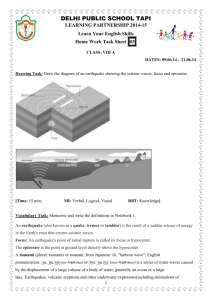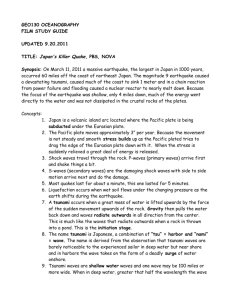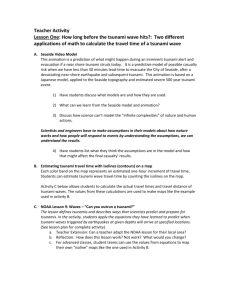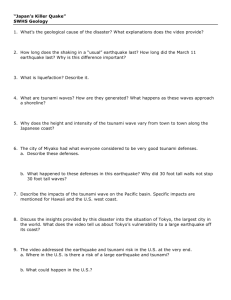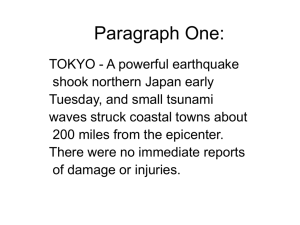Waves and Surfing PPT
advertisement
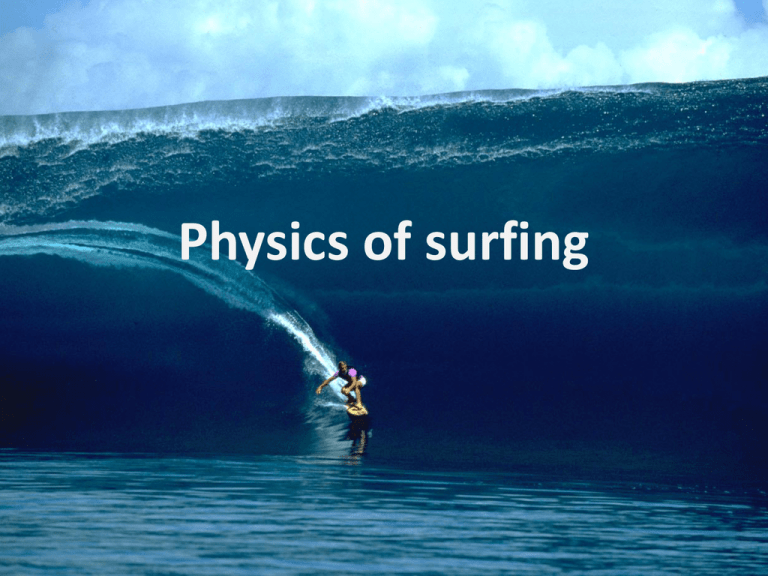
Physics of surfing videos • Science of Big Waves (KQED) • Garrett McNamara w/ GoPro, 90’+ • Teahupoo raw 2013 The energy of a wave travels ahead but the water itself does not Why are there consistently bigger waves in the Pacific? Factors determining wave power: wind v, wind duration, and fetch Why are the conditions so different? Ground swell vs. wind swell Seafloor determines wave (shape) Wave energy consolidates due to DIFFRACTION To what depth would a seasick scuba diver have to go for relief? Breakers form In roughly ½ of the wavelength. So if there is a longer period, you have bigger waves. What is shown here? So what are ideal surf conditions? So what are ideal surf conditions? • Wind: off-shore, not too strong So what are ideal surf conditions? • Wind: off-shore, not too strong • Period: long (ground swell) So what are ideal surf conditions? • Wind: off-shore, not too strong • Period: long (ground swell) • Tide: dependent on particular break location So what are ideal surf conditions? • • • • Wind: off-shore, not too strong Period: long (ground swell) Tide: dependent on particular break location Substrate: sudden rise, reef, often a point how heavy is a big wave? > 1 ton per 1 3 m Forces in balance while riding Useful sites • Magic Seaweed • Surf-forecast.com Other types of waves CAPILLARY WAVES A seiche is a standing wave in an enclosed or partially enclosed body of water. Seiches have been observed on lakes, reservoirs, swimming pools, bays, harbors and seas. A tsunami (at one time incorrectly referred to as a tidal wave), is a series of water waves caused by the displacement of a large volume of a body of water, usually an ocean. Created by: Earthquakes, volcanic eruptions and other underwater explosions, landslides glacier calvings and meteorite ocean impacts 2004 Indian Ocean Tsunami - Indonesia 35 meters high on shore - 176,000 fatalities Diffracted around world, even to RI Tsunami videos Japan 2011-raw: video Japan 2011: National Geographic Tsunami 101: National Geographic Cartoon overview of tsunami: http://www.penmachine.com/podcast/audio/Entries/2008/3/5_Tsunami_video_from_VFS.html 2 interactives of 2004 tsunami: http://www.pbs.org/wgbh/nova/tsunami/ See 1st chapters of America’s Tsunami: Are We Next? How Stuff Works.com 2004 first waves: http://videos.howstuffworks.com/discovery/27966-assignment-discovery-first-waves-of-2004-tsunami-video.htm How the 2004 tsunami happened: http://videos.howstuffworks.com/discovery/27965-assignment-discovery-how-the-2004tsunami-happened-video.htm 2004 Plate shift: http://videos.howstuffworks.com/discovery/14049-tsunami-2004-indian-ocean-plate-shift-video.htm 2004 teletsunami, India: http://videos.howstuffworks.com/discovery/27976-assignment-discovery-teletsunami-video.htm Pacific Warning System: http://videos.howstuffworks.com/discovery/27978-assignment-discovery-pacific-warning-systemvideo.htm Tsunami warning system: http://videos.howstuffworks.com/discovery/29454-assignment-discovery-tsunami-warning-systemvideo.htm Mega Tsunami: http://videos.howstuffworks.com/discovery/27977-assignment-discovery-mega-tsunami-video.htm Megatsunami videos • • • • Alaska Deep Impact Could RI be hit tomorrow? La Palma, Canary Islands (no sound) Celerity (another name for speed) C = L/T L = wavelength (m) C = 1.25√L d = depth (m) C = 1.56 T C = celerity (m/s) C = √gd = 3.1√d T = period (s) Wind Waves (deep) Seismic Waves (shallow) Period ≈ 20 seconds Period ≈ 20 minutes L to ≈ 600 m L to ≈ 200 km So C can reach 112 km/hr So C can reach 760 km/hr

